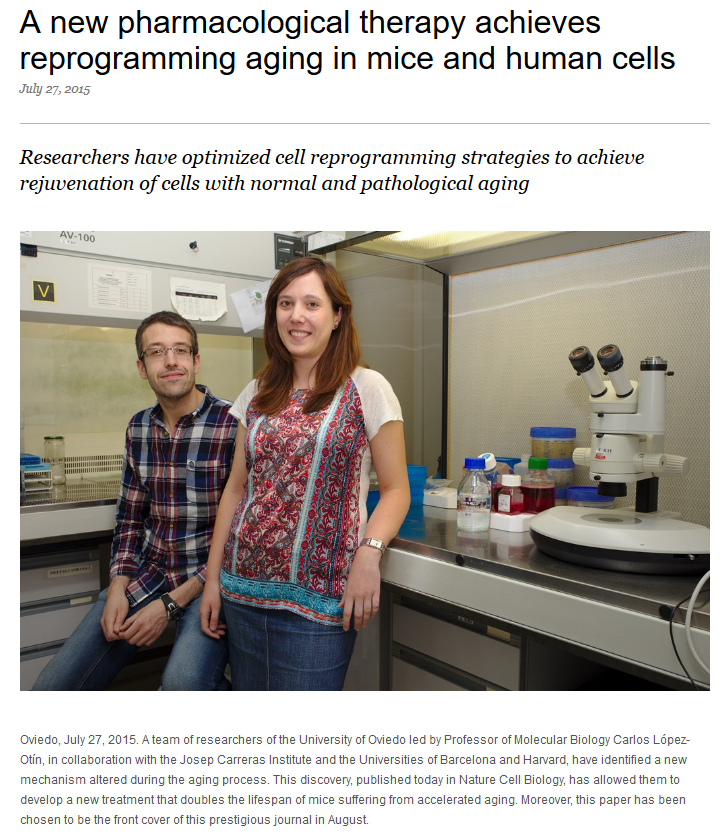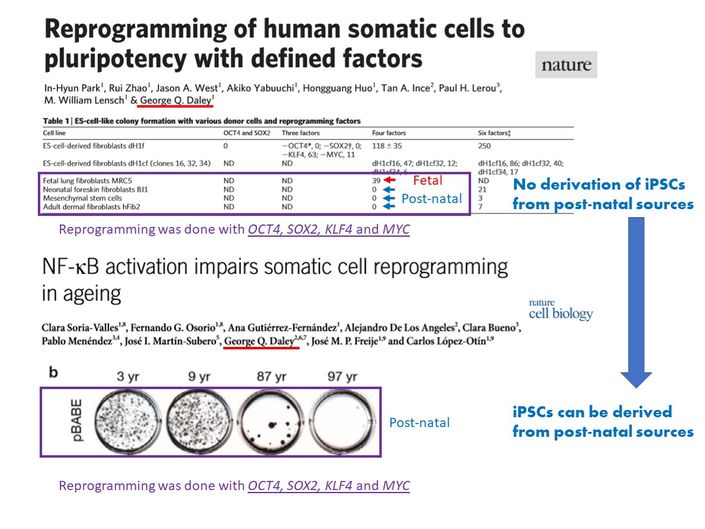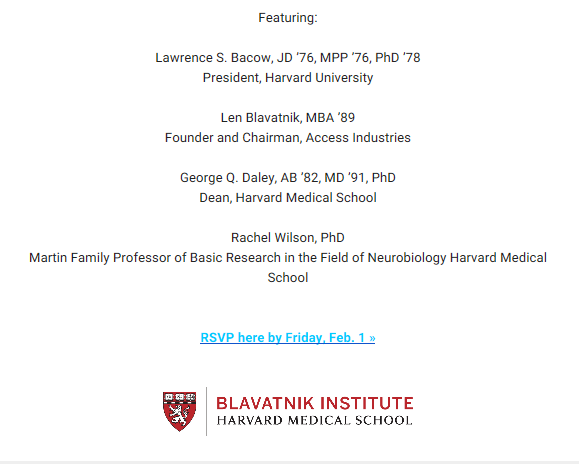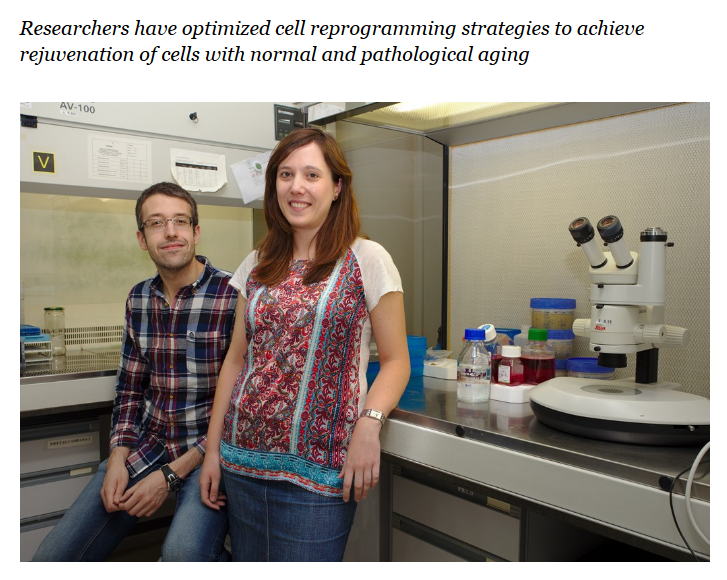Boom, the 2015 Nature Cell Biology paper by the famous, award-winning and now fugitive Spanish cancer and ageing researcher Carlos Lopez-Otin and his US partner George Q Daley, stem cell titan and dean of Harvard Medical School, is retracted. That happens because correct original data was unavailable, prompted by a prolonged debate on PubPeer (which in turn followed my reporting on Lopez-Otin’s data integrity practices), which established that the figures do not match what the authors deposited as supplement.
The paper Soria-Valles et al 2015 established the role of the transcription factor protein NF-kB in cellular senescence and cell reprogramming, while offering a potential cure to child patients suffering from the deadly premature ageing syndrome, such as Néstor–Guillermo or Hutchinson–Gilford progeria. Under this premise, the impactful Nature-themed paper earned Lopez-Otin in 2017 an ERC grant of €2.5 million, for a project named “Deconstructing Ageing: from molecular mechanisms to intervention strategies“. Earlier this year however, Lopez-Otin abandoned his ERC funded lab at University of Oviedo and escaped to Paris, to stay with his Photoshop expert friend Guido Kroemer. If past behaviour is anything to go by, ERC will now probably again play three monkeys and pretend that Lopez-Otin is still in Spain and his grant-deciding Nature Cell Biology paper was never retracted.
Another Soria-Valles et al paper from Daley lab, which proposed a way to produce haematopoietic stem cells via iPS technology and save people with leukaemia, was meant to be already published, but it is not even submitted and might never be. This and the retracted study’s first author Clara Soria-Valles was a former PhD student of Lopez-Otin, funded by EMBO postdoctoral fellowship and delegated to the Harvard labs of Daley and his junior partner Thorsten Schlaeger, to learn cellular reprogramming technique. Daley and Schlaeger are reported to be all but ready to apply the blood cell making technique in the clinic, at Boston Children’s Hospital, but now nobody knows if Soria-Valles’ preclinical data is anywhere near reproducible.
It is indeed difficult to find out what results still might be reliable. Soria-Valles disappeared already in April 2018 on a medical leave, though Daley still pays her (neither Daley nor Harvard normally pays any medical leaves for other sick lab members). Nobody else on that manuscript is available, because the Schlaeger lab people involved also left since. Money to try and reproduce it is not an issue though: the research project was funded from Daley’s biggest grant, the NHLBI Progenitor Cell Translational Consortium (NIH U01), which is worth almost $50 million.

As I was informed, that Soria-Valles paper on haematopoietic reprogramming was meant to be originally submitted to the elite Cell family journal Cell Stem Cell (this is how the circulated draft was labelled in April 2018). Later on, roughly in August 2018, when my article appeared, the chosen target journal was Stem Cell Reports (published by International Society for Stem Cell Research, ISSCR). For someone like Daley this is a huge status reduction of journal venue. The results were presented earlier by Soria-Valles at the ISSCR annual meeting in 2017:
INTEGRATION-FREE SYSTEM FOR GENERATION OF HEMATOPOIETIC STEM AND PROGENITOR CELLS FROM HUMAN PLURIPOTENT STEM CELLS
Soria-Valles, Clara 1 , Sugimura, Ryohichi 1 , Kumar Jha, Deepak 1 , Lummertz da Rocha, Edroaldo 1 and Daley, George 2
1 Boston Children’s Hospital, Boston, MA, USA, 2 Stem Cell Program, Boston Children´s Hospital, Boston, MA, USA
The generation of hematopoietic stem cells (HSCs) from human pluripotent stem cells (PSCs) constitutes a valuable tool with promising applications for research and therapy. However, derivation of HSCs with in vivo long-term engraftment and multi-lineage potential remains elusive. We have described a combinatorial approach, based on the directed differentiation of hemogenic endothelium (HE) and transduction with five transcription factors (TF) (RUNX1, ERG, LCOR, HOXA5 and HOXA9) expressed in lentiviral vectors that allowed the conversion of human PSCs into hematopoietic stem
and progenitor cells (HSPCs). The resulted cells exhibited long-term and multi-lineage hematopoietic capabilities when injected into irradiated immune-deficient mice.
Despite this proof of principle, the engineered cells have a limited self-renewal capacity due to the integration of the transgenes and are still molecularly distinct from bona fide HSCs. Thus, in an attempt to achieve bona fide HSCs and make them safer for future therapeutic interventions, we have established integration-free systems that have shown comparable efficiency to the previously developed lentiviral strategy through in vitro and in vivo experiments. Therefore, this new method may overcome some limitations of the lentiviral approach and hold the key for future regenerative medicine advances in blood diseases.
Soria-Valles however was not present at the 2018 ISSCR meeting (a conference which I incidentally wrote about here, in a story about another dishonest stem cell researcher, who was set to be ISSCR 2018 keynote speaker). Nobody knows how much of Soria-Valles’ claim to make haematopoietic stem cells via iPS technology is still valid. Sources were quoted with estimates of too low a yield or even not sure of producing any haematopoietic stem cells at all. Yet just this September 2018, Daley spoke at a lecture at Dana-Farber-Institute of his future Stem Cell Reports paper and even of his plans to apply the method to treat paediatric patients with congenital bone marrow deficiencies, in particular Shwachman Diamond Syndrome and Diamond Blackfan Anemia.

But now back to the main subject, the Nature Cell Biology retraction. The journal warned readers on 4 October 2018 with an editorial note that “that the reliability of data presented in this manuscript has been the subject of criticisms“. 4 December 2018 was the deadline imposed by the publisher to submit signatures from co-authors for a retraction. Lopez-Otin’s Oviedo colleague Jose Maria Perez Freije collected the signatures of all authors, including the elusive Soria-Valles, and submitted them to the publisher Nature.
This is the retraction notice:
“We, the authors, are retracting this Article due to issues that have come to our attention regarding data availability, data description and figure assembly. Specifically, original numerical data are not available for the majority of the graphs presented in the paper. Although original data were available for most EMSA and immunoblot experiments, those corresponding to the published EMSA data of Supplementary Fig. 8a, the independent replicate immunoblots of Fig. 8b and Supplementary Fig. 1e, and the independent replicate EMSA data of Supplementary Figs 6e, 8b, 8c and 8d, are unavailable. Mistakes were detected in the presentation of Figs 3c, 4i and Supplementary Figs 6a, 8a, 8d, 9, and in some cases the β-actin immunoblots were erroneously described in the figure legends as loading controls, rather than as sample processing controls that were run on separate gels. Although we, the authors, believe that the key findings of the paper are still valid, given the issues with data availability we have concluded that the most appropriate course of action is to retract the Article. We deeply regret these errors and apologize to the scientific community for any confusion this publication may have caused. All authors agree with the retraction.”
This slide show illustrates the data issues mentioned in the retraction notice.
And this slide show illustrates the issues the retraction notice chose not to address at all.
In Daley’s lab, more things do not work as expected. His most famous Nature paper, Park et al 2008 , meant to compete with Shinya Yamanaka for induced pluripotency (iPS) fame and the Nobel Prize, is being plucked apart on PubPeer, accused of not having delivered any pluripotency as such. The exogenously delivered reprogramming transgenes remained namely active, while they were supposed to become silenced as cells’ own pluripotency genes become active. Also, Daley’s method of using Large T Antigen and telomerase TERT in addition to Yamanaka’s four iPS reprogramming factors proved rather counterproductive.

For someone like Daley, all of this is not the end of the world. There are always new windows of opportunity. Just as Chinese scientist Jiankui He caused a worldwide scandal with his unethical human experiments with CRISPR-modified babies, Daley (and his Harvard colleague George Church) offered a more enthusiastic view: America cannot afford a CRISPR gap to China. Daley suggested that Harvard should take the lead and apply CRISPR eugenics to ensure the survival of the human race:
“There have even been discussions that we as a species need to maintain the flexibility in the face of future threats to take the control of our own heredity.”
Harvard’s CRISPR experiments on human germ line editing are already starting. An Alzheimer’s associated gene is to be edited in human sperm, while Daley announced big plans to design the children of the future to be resistant to various diseases. Ethics is something this Harvard dean is apparently less interested in.
Harvard recently received a $200 million donation to set up a new institute, the money came from a controversial tycoon Leonard Blavatnik with Russian origins, whose lawyers made The Guardian apologise for erroneously calling him a “Putin pal” and an oligarch.
It is Daley’s Spanish collaborator, the fugitive Lopez-Otin, who is in deep trouble with that retraction now. Lopez-Otin did manage to bring himself into news recently with his new paper (in a Nature -themed journal!) where his Oviedo lab analysed the genome of Lonesome George, the last member of his giant tortoise species who died in 2012. The press release omitted to say whether he spoke from Oviedo or Paris, Lopez-Otin the turtle geriatrics researcher was quoted with:
“We had previously described nine hallmarks of aging, and after studying 500 genes on the basis of this classification, we found interesting variants potentially affecting six of those hallmarks in giant tortoises, opening new lines for aging research”
Nature now probably deeply regrets having awarded him with a 2017 Mentoring Award. Maybe they can give next one to Daley? Maybe Daley can get Soria-Valles to CRISPR some of those turtle genes to create a new long-lived human race of Homo harvardiensis crispri?
Update 21.12.2018. My article was apparently well received in Harvard, according to this information I was privy to:
“Daley was complaining intensely at lab meeting in front of entire lab and his junior faculty labs (Trista North and Thorsten Schlaeger) about potential lab members who might have leaked Soria-Valles information to the German blogger. It was intense”
I also learned that the now retracted Soria-Valles Nature Cell Biology 2015 paper was originally submitted to Science, were it was rejected due to some statistics issues.
Update 5.01.19. I was recently alerted by a source:
“George [Daley, -LS] has scared the lab members and provoked Stockholm syndrome among members. The Daley lab is trying to figure out who the leaks are now. Some of the members are trying to crash the German website by sending Hakenkreuz images.”
This was exactly what happened. Commenters used several fake identities to post highly defamatory comments about Daley on my site, equalling his research to Macchiarini’s trachea transplants and, indeed, using Nazi Swastika armband photoshopped on a photo of Daley. Exactly same picture was shared by Daley lab members in preparation of the campaign, it was confirmed to me. I deleted all those comments, but made backup, also of IP addresses.
Specifically, those IP addresses were located in US to Connecticut, 06902 Stamford, and New York State, 10022 New York. My source suggested I contact these Daley lab alumni: In-Hyun Park at Yale, CT, and Kitai Kim at MSKCC in NY, as well as the person allegedly orchestrating the campaign, the current Daley postdoc Deepak Jha. None of them replied, but Jha immediately blocked me on Twitter. This is how some grown men behave to please their mighty (ex-)boss. Maybe they should rather relax and read the book by Daley’s wife, Amy C. Edmondson, “The Fearless Organization: Creating Psychological Safety in the Workplace for Learning, Innovation, and Growth“.
Daley will be opening the Blavantik institute in ceremony on February 5th, at 5:30 PM. Come to talk about plans of CRISPR babies!


Donate!
If you are interested to support my work, you can leave here a small tip of $5. Or several of small tips, just increase the amount as you like (2x=€10; 5x=€25). Your generous patronage of my journalism will be most appreciated!
€5.00


Good news!
It was good that other shameless Nature papers would be also retracted
LikeLike
What will happen to Soria-Valles Stem Cell Reports? Given her Nature Cell Biology retracted, can the author with retraction history submit to other journals and continue research work?
LikeLike
We should wait that cheater learn the lesson, and overall that the science has a powerful weapon to catch them.
LikeLike
Thank you Leonid for your tremendous contribution to science.
I started the discussion regarding the Nature Cell Biology paper by Soria Valles on PubPeer one year ago after I got inspiration from your article about Lopez-Otin.
I will continue to fight against the cheaters and will encourage all the vigilant scientist out there to stand up against the producers of fake science. Put pressure on those “scientist” and the journals and research institutes which protect them.
LikeLike
First retraction ever from both Daley and Lopez-Otin.
LikeLike
Another Daley’s most famous Nature paper to claim possible ectogenesis of life was under debate on PubPeer about its reproducibility and image fabrication.
Derivation of embryonic germ cells and male gametes from embryonic stem cells
Nature (2004) – 3 Comments
pubmed: 14668819 doi: 10.1038/nature02247 issn: 1476-4687 issn: 0028-0836 issn: 1476-4679
Niels Geijsen , Melissa Horoschak , Kitai Kim , Joost Gribnau , Kevin Eggan , George Q. Daley
https://pubpeer.com/publications/A338DD5840B3ED818917AEB1B984C5
“Indeed 10 years later and this method has not been adopted or reproduced. ”
“The Daley group should have applied their guidelines for establishing provenance of pluripotent states
( https://pubpeer.com/publications/8029B0E58FBD9134E9AEA36BB096F9#fb37135 )
( https://pubpeer.com/publications/F92E647912A9DBF17A3319600A1945#fb37163 ), on their previous study claiming the generation of functional sperm from mouse ESCs published in Nature 2004, which remains to be reproduced!!!!
They should have reproduced this controversial study and used “forensic genomics” to establish provenance of in vitro generated haploid male gametes and sperm. Alternatively, publishing “Failure to replicate the STAP cell phenomenon” in 2015, would have made a good occasion to retract Geijsen et al. 2004 paper. ”
“Image splicing.”
LikeLike
One of the current lab members at Daley’s lab is a postdoctoral fellow named Pavlos Missios. He did his PhD under Karl Lenhard Rudolph who was accused of profound scientific misconduct (https://forbetterscience.com/2017/06/27/german-leibniz-institute-director-karl-lenhard-rudolph-guilty-of-misconduct/) as 8 of Rudolph’s had evidence of data fabrication/manipulation. Pavlos Missios is the primary author of one of those 8 paper which also been criticized on pubpeer (https://pubpeer.com/publications/31B3D6A98C16815ABD9FAAC8364887?fbclid=IwAR0O5M0p6zN8SYZasEwgH5ThS0-KCs63RDxicohxt2zXel5zycyaJlyimA8).
Collectively such incidences suggest that Daley is inclined in recruiting such postdocs.
LikeLike
Why this retraction note avoided to address more issues? The notice only addressed superficially. Daley and Lopez-Otin still want to hide some worse detail of this paper?
“And this slide show illustrates the issues the retraction notice chose not to address at all.”
LikeLike
Unfortunately the truth behind many iconic papers maybe quite sinister and their revelation even a scandal to governments
LikeLike
Comparing with Daley’s talk at DFCI this Sept. 2018, his following NIH talk Nov. 2018 dramatically shrunk Soria-Valles work. He did not repeat his claim that “(Soria-Valles’) haematopoietic stem cells showed similar capacity as cord blood haematopoietic stem cells” that was most outstanding point at DFCI talk.
56-57: Soria-Valles work in three slides
57-59: Daley proposed scale-up production strategy to test Soria-Valles haematopoietic stem cells in human patients.
https://videocast.nih.gov/summary.asp?Live=28849&bhcp=1
LikeLike
Apparently, the retraction note was written in too mild manner. As you described in the slide show, most of critical points from pubpeer were not chosen to address. These include progeria patients’ sample swapping in figure 6b; aged donors’ sample swapping in figure 7a, contradictory expression of pluripotent genes in adult cells in figures 6g, 7f; and band-donor films used throughout in entire paper.
LikeLike
Pingback: Aperto al dibattito - Ocasapiens - Blog - Repubblica.it
“award-winning and now fugitive Spanish cancer and ageing researcher”, now fugitive? Did I miss any fun here?
LikeLike
It is grossly inappropriate and in bad taste to insinuate “any fun” in the fact that Carlos (who is a dashing gentleman indeed) moved to Paris to stay with Guido Kroemer and his charming partner Laurence Zitvogel.

https://forbetterscience.com/2018/10/18/lopez-otin-and-kroemer-birds-of-a-feather-flock-together/
LikeLike
Shame on you, Mr Schneider! Spreading rumours and gossip is certainly a curious way to dignify science.
LikeLiked by 1 person
Soria-Valles’ thesis was based on now retracted Nature Cell Biology paper and another PubPeer alleged Oncogene paper on which they deposited someone else’s irrelevant microarray data from irrelevant tissue as their own breast cancer microarray data. https://pubpeer.com/publications/8D0F4C1D83621DE5F72E92A4C39787
The act of defending the Thesis of Dna. Clara Soria Valles, titled “Tissue remodeling and cell reprogramming in cancer and aging” directed by Dr. Carlos Lopez Otin and Dr. Ana Y. Gutierrez Fernandez, will take place on June 12 at 12.00 in the Sala de Grados of the Faculty of Medicine.
http://bbm.uniovi.es/noticias/-/asset_publisher/0002/content/cara-soria?redirect=http://bbm.uniovi.es/inicio
LikeLike
A PhD thesis in Spain as far as I know is supposed to be an original, unpublished work with the exceptions of certain regions in Spain where they follow the Dutch model where a PhD thesis is a compilation of published papers
If a PhD student comes from a big lab will be very difficult he/she gets enough attention from their supervisor which maybe just interested in adding more PhD theses to his/her CV as well as nature papers rather than conveniently forming someone to be a competent researcher
LikeLike
Dear Ana, I don’t know if you are Spaniard or Hispanic, but as Spaniard, my thesis is the addition of 3 articles published on international peer-reviewed journals. I think that very probably in big labs and is not the case of the Otin one, the student can cheat easily the PI. Hence, in these cases, the punishment should lie on the student. If Otin is compulsively cheating then is when he should be investigated.
Does somebody know what will happen to this young first author-researcher?
LikeLike
Razielclein,
Lopez-Otin has 23 of problematic papers with copy-paste of images. The retracted Nature Cell Bio. paper was a flagship of a fleet of their problematic papers.
https://forbetterscience.com/2018/05/07/the-perennial-northern-blot-of-lopez-otin/
Soria-Valles mocked data deposition policy not only for Nature Cell Bio. but also for another npg journal Oncogene. They, instead of their own, linked microarray data of someone else’s lab of totally irrelevant samples.
I assume all these papers are under investigation.
LikeLike
“Does somebody know what will happen to this young first author-researcher?”
The first author Clara Soria-Valles safely returned back to her home university with fund from Spanish government called Juan de la Cierva-incorporación. The Spanish system encourages cheaters, rather giving them penalty.
LikeLike
G Marino is the first author of two retracted papers with Lopes-Otin as last author, both of which were part of his PhD thesis (https://www.educacion.gob.es/teseo/mostrarRef.do?ref=409845). Marino currently holds a Ramon y Canal grant from the Spanish Government. This is a very competitive position, and many other candidates have been rejected. What does happen now to his PhD thesis and grants? Should I have cheated in my papers????
LikeLike
The Retraction Watch Database indexed this paper and all authors.
LikeLike
I inquired Oncogene editors to dig into Soria-Valles’ microarray data and original numerical data to make graphs in the article.
The chief editor Dr. Stebbing said he will deal with this.
LikeLike
Another reader on PubPeer argues back that gel splicing seems nitpicky.
Derivation of embryonic germ cells and male gametes from embryonic stem cells
Nature (2004) – 4 Comments
pubmed: 14668819 doi: 10.1038/nature02247 issn: 1476-4687 issn: 0028-0836 issn: 1476-4679
Niels Geijsen , Melissa Horoschak , Kitai Kim , Joost Gribnau , Kevin Eggan , George Q. Daley
https://pubpeer.com/publications/A338DD5840B3ED818917AEB1B984C5
“Whether the findings in this paper are truly reproducible is a worrisome question, but it’s hard to see how the splicing in figure 2D is terribly problematic. I would imagine the gel comb has 24 wells and therefore some combining of non-adjacent images would be necessary here, either at the position shown or just before the controls. It’s actually better that the experimenter put some experimental lanes together with the control lanes, rather than probing the controls separately. No, there isn’t a separation between the non-contiguous membranes, but the splice is quite obvious and this is a 2004 paper. Seems nitpicky to me.”
LikeLike
If one has so many samples that a second gel is needed, one should also load control samples on both gels. Unless this is a Harvard paper meant for Nature, of course.
LikeLike
Complex history of biorxiv pre-print from Daley. How many reincarnation this pre-print needs to be real print?
Short hairpin RNAs artifactually impair cell growth and suppress clustered microRNA expression
bioRxiv (2018) – 7 Comments
doi: 10.1101/372920
John Powers author has email , Edroaldo Lummertz Da Rocha , Daniel Pearson , Pavlos Missios , Tarja Yvanka De Soysa , Jessica Barragan , Patrick Cahan author has email , George Daley
https://pubpeer.com/publications/5D8FDD6767EE6F2424B5D9B0164CF7
“You can find the original version here. https://www.biorxiv.org/content/early/2018/12/11/372920.article-info I found the article has two older versions. The mistake of copy-paste and splicing was introduced in the first version (July 20, 2018), stil remained in the second version (July 26, 2018), and finally replaced with new images in the latest version (December 11, 2018). The second version added two missing references to introduce this sentence ” LentiCRISPRv2 was a gift from F. Zhang19,20.”
LikeLike
Soria-Valles’ NCB paper (2015) was retracted and finally removed from Lopez-Otin lab website.
http://degradome.uniovi.es/publications.html
Selected publications from our lab
Ferrando, A. A. and Lopez-Otin, C. Clonal evolution in leukemia. Nature Med, 23, 1135-1145 (2017). PubMed
de la Rosa, J., Weber, J., Friedrich, M. J., Li, Y., Rad, L., Ponstingl, H., Liang, Q., de Quiros, S. B., Noorani, I., Metzakopian, E., Strong, A., Li, M. A., Astudillo, A., Fernandez-Garcia, M. T., Fernandez-Garcia, M. S., Hoffman, G. J., Fuente, R., Vassiliou, G. S., Rad, R., Lopez-Otin, C., Bradley, A. and Cadinanos, J. A single-copy Sleeping Beauty transposon mutagenesis screen identifies new PTEN-cooperating tumor suppressor genes. Nature Genet, 49, 730-741 (2017). PubMed
Lopez-Otin, C., Galluzzi, L., Freije, J. M., Madeo, F. and Kroemer, G. Metabolic Control of Longevity. Cell, 166, 802-21 (2016). PubMed
Osorio, F. G., Soria-Valles, C., Santiago-Fernandez, O., Bernal, T., Mittelbrunn, M., Colado, E., Rodriguez, F., Bonzon-Kulichenko, E., Vazquez, J., Porta-de-la-Riva, M., Ceron, J., Fueyo, A., Li, J., Green, A. R., Freije, J. M. and Lopez-Otin, C. Loss of the proteostasis factor AIRAPL causes myeloid transformation by deregulating IGF-1 signaling. Nature Med, 22, 91-6 (2016). PubMed
Puente, X. S., et al. Non-coding recurrent mutations in chronic lymphocytic leukaemia. Nature, 526, 519-24 (2015). PubMed
Quiros, P. M., Langer, T. and Lopez-Otin, C. New roles for mitochondrial proteases in health, ageing and disease. Nature Rev Mol Cell Biol, 16, 345-59 (2015). PubMed
Robles-Espinoza, C. D.,et al. POT1 loss-of-function variants predispose to familial melanoma. Nature Genet, 46, 478-81 (2014). PubMed
2015
Loi, M., Cenni, V., Duchi, S., Squarzoni, S., Lopez-Otin, C., Foisner, R., Lattanzi, G. and Capanni, C. Barrier-to-autointegration factor (BAF) involvement in prelamin A-related chromatin organization changes. Oncotarget, 7, 15662-77 (2016). PubMed
Alioto, T. S., et al. A comprehensive assessment of somatic mutation detection in cancer using whole-genome sequencing. Nature Commun, 6, 10001 (2015). PubMed
Puente, X. S., et al. Non-coding recurrent mutations in chronic lymphocytic leukaemia. Nature, 526, 519-24 (2015). PubMed
Xargay-Torrent, S., Lopez-Guerra, M., Rosich, L., Montraveta, A., Roldan, J., Rodriguez, V., Villamor, N., Aymerich, M., Lagisetti, C., Webb, T. R., Lopez-Otin, C., Campo, E. and Colomer, D. The splicing modulator sudemycin induces a specific antitumor response and cooperates with ibrutinib in chronic lymphocytic leukemia. Oncotarget, 6, 22734-49 (2015). PubMed
Gutierrez-Fernandez, A., Soria-Valles, C., Osorio, F. G., Gutierrez-Abril, J., Garabaya, C., Aguirre, A., Fueyo, A., Fernandez-Garcia, M. S., Puente, X. S. and Lopez-Otin, C. Loss of MT1-MMP causes cell senescence and nuclear defects which can be reversed by retinoic acid. EMBO J, 34, 1875-88 (2015). PubMed
Rodriguez, D., Bretones, G., Quesada, V., Villamor, N., Arango, J. R., Lopez-Guillermo, A., Ramsay, A. J., Baumann, T., Quiros, P. M., Navarro, A., Royo, C., Martin-Subero, J. I., Campo, E. and Lopez-Otin, C. Mutations in CHD2 cause defective association with active chromatin in chronic lymphocytic leukemia. Blood, 126, 195-202 (2015). PubMed
Quiros, P. M., Langer, T. and Lopez-Otin, C. New roles for mitochondrial proteases in health, ageing and disease. Nature Rev Mol Cell Biol, 16, 345-59 (2015). PubMed
Cal, S. and Lopez-Otin, C. ADAMTS proteases and cancer. Matrix Biol, 44-46C, 77-85 (2015). PubMed
Cabrera, S., Maciel, M., Herrera, I., Nava, T., Vergara, F., Gaxiola, M., Lopez-Otin, C., Selman, M. and Pardo, A. Essential role for the ATG4B protease and autophagy in bleomycin-induced pulmonary fibrosis. Autophagy, 11, 670-84 (2015). PubMed
Aguilera, O., Gonzalez-Sancho, J. M., Zazo, S., Rincon, R., Fernandez, A. F., Tapia, O., Canals, F., Morte, B., Calvanese, V., Orgaz, J. L., Niell, N., Aguilar, S., Freije, J. M., Grana, O., Pisano, D. G., Borrero, A., Martinez-Useros, J., Jimenez, B., Fraga, M. F., Garcia-Foncillas, J., Lopez-Otin, C., Lafarga, M., Rojo, F. and Munoz, A. Nuclear DICKKOPF-1 as a biomarker of chemoresistance and poor clinical outcome in colorectal cancer. Oncotarget, 6, 5903-17 (2015). PubMed
Wallace, D. F., Secondes, E. S., Rishi, G., Ostini, L., McDonald, C. J., Lane, S. W., Vu, T., Hooper, J. D., Velasco, G., Ramsay, A. J., Lopez-Otin, C. and Subramaniam, V. N. A critical role for murine transferrin receptor 2 in erythropoiesis during iron restriction. Br J Haematol, 168, 891-901 (2015). PubMed
Rodriguez, D., Bretones, G., Arango, J. R., Valdespino, V., Campo, E., Quesada, V. and Lopez-Otin, C. Molecular pathogenesis of CLL and its evolution. Int J Hematol, 101, 219-28 (2015). PubMed
Bassaganyas, L., Bea, S., Escaramis, G., Tornador, C., Salaverria, I., Zapata, L., Drechsel, O., Ferreira, P. G., Rodriguez-Santiago, B., Tubio, J. M., Navarro, A., Martin-Garcia, D., Lopez, C., Martinez-Trillos, A., Lopez-Guillermo, A., Gut, M., Ossowski, S., Lopez-Otin, C., Campo, E. and Estivill, X. Sporadic and reversible chromothripsis in chronic lymphocytic leukemia revealed by longitudinal genomic analysis. Leukemia, 29, 758 (2015). PubMed
Queiros, A. C., Villamor, N., Clot, G., Martinez-Trillos, A., Kulis, M., Navarro, A., Penas, E. M., Jayne, S., Majid, A., Richter, J., Bergmann, A. K., Kolarova, J., Royo, C., Russinol, N., Castellano, G., Pinyol, M., Bea, S., Salaverria, I., Lopez-Guerra, M., Colomer, D., Aymerich, M., Rozman, M., Delgado, J., Gine, E., Gonzalez-Diaz, M., Puente, X. S., Siebert, R., Dyer, M. J., Lopez-Otin, C., Rozman, C., Campo, E., Lopez-Guillermo, A. and Martin-Subero, J. I. A B-cell epigenetic signature defines three biologic subgroups of chronic lymphocytic leukemia with clinical impact. Leukemia, 29, 598-605 (2015). PubMed
Keane, M., Semeiks, J., Webb, A. E., Li, Y. I., Quesada, V., Craig, T., Madsen, L. B., van Dam, S., Brawand, D., Marques, P. I., Michalak, P., Kang, L., Bhak, J., Yim, H. S., Grishin, N. V., Nielsen, N. H., Heide-Jorgensen, M. P., Oziolor, E. M., Matson, C. W., Church, G. M., Stuart, G. W., Patton, J. C., George, J. C., Suydam, R., Larsen, K., Lopez-Otin, C., O’Connell, M. J., Bickham, J. W., Thomsen, B. and de Magalhaes, J. P. Insights into the evolution of longevity from the bowhead whale genome. Cell Rep, 10, 112-22 (2015). PubMed
Caravia, X. M. and Lopez-Otin, C. Regulatory Roles of miRNAs in Aging. Adv Exp Med Biol, 887, 213-30 (2015). PubMed
Soria-Valles, C., Osorio, F. G. and Lopez-Otin, C. Reprogramming aging through DOT1L inhibition. Cell Cycle, 14, 3345-6 (2015). PubMed
Galluzzi, L., et al. Essential versus accessory aspects of cell death: recommendations of the NCCD 2015. Cell Death Differ, 22, 58-73 (2015). PubMed
Fernandez, A. F. and Lopez-Otin, C. The functional and pathologic relevance of autophagy proteases. J Clin Invest, 125, 33-41 (2015). PubMed
Lopez-Guerra, M., Xargay-Torrent, S., Rosich, L., Montraveta, A., Roldan, J., Matas-Cespedes, A., Villamor, N., Aymerich, M., Lopez-Otin, C., Perez-Galan, P., Roue, G., Campo, E. and Colomer, D. The gamma-secretase inhibitor PF-03084014 combined with fludarabine antagonizes migration, invasion and angiogenesis in NOTCH1-mutated CLL cells. Leukemia, 29, 96-106 (2015). PubMed
In contrast, Daley lab website still displays this paper in Publication section.
https://daley.med.harvard.edu/publications
LikeLike
Does anyone know there are any progeria patients and researchers associations in europe, Spain, US etc? They need to be alerted that Harvard, International society of stem cell research and uniovi produced a big fake hope using public fund of EMBO.
LikeLike
Progeria Research Foundation has been operating clinical trials to progeria kids since 2007 at Boston Children’s Hospital, where Soria-Valles’ progeria study took place at the Daley lab located there. The study was published in Nature Cell Biology and retracted by now.
https://www.progeriaresearch.org/clinical-trials/
The clinical trial is based on 2003 discovery of progeria gene lamin A in HGPS progeria by Francis Collins, NIH director. Soria-Valles’ retracted study proposed a method to rejuvenate HGPS patients cells, where they swapped samples to make up the claim.
“Twenty-eight (28) children from sixteen countries participated, ages 3 to 15 years. Children returned to Children’s Hospital Boston every four months, for testing and to receive new drug supply, and stayed in Boston for 4-8 days each visit. While at home, their doctors kept a close watch over the children and submitted periodic health reports to the Boston research team. For the duration of the trial, an average of 2 children per week traveled to Boston to participate.”
LikeLike